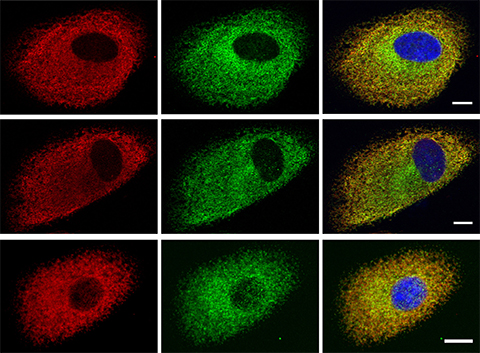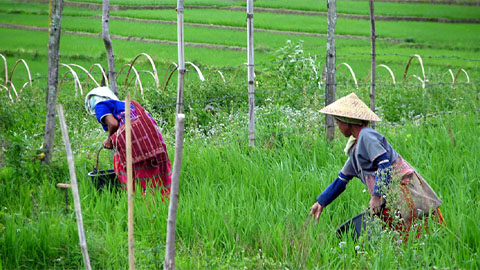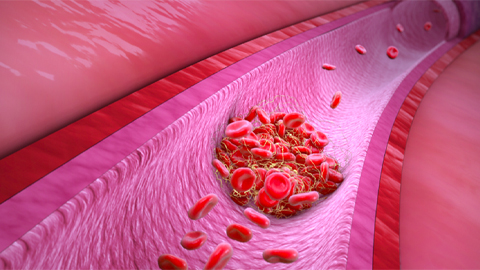ELOVL4 mutations: Two sides of the same coin
Fatty acids constitute cellular membranes, fuel energy production and act as signaling molecules. Long-chain fatty acids have tails of 13 to 21 carbons. The enzymes known as ELOVLs — short for “elongation of very long” — can extend these tails to make them into very long-chain saturated and very long-chain unsaturated fatty acids, known respectively as VLC-SFAs and VLC-PUFAs. Defects in the elongation of fatty acids can cause neuronal, ocular and skin problems.

Martin-Paul Agbaga, an assistant professor of cell biology and ophthalmology at the University of Oklahoma Health Sciences Center, studies the intersection between very long-chain fatty acids and human disease. In a recent publication in the Journal of Lipid Research, Agbaga and his team, which included Yeboah Kofi Gyening, described the mechanisms by which specific ELOVL4 mutations affect particular tissues.
“We are trying to figure out why some patients with ELOVL4 mutations only have retinal dysfunction, some only have brain dysfunction, and some only have skin dysfunction,” Gyening, a recent Ph.D. graduate, said. “We are basically asking why the same mutation is causing such diverse phenotypes.”
The team studied how two ELOVL4 mutants, one associated with brain disorders and the other with skin disease in humans, elongate a precursor fatty acid. They found that both these mutations had some limited capacity to elongate PUFA precursors to VLC-PUFA but blunted the enzyme’s capability to biosynthesize VLC-SFAs.
The question of how the same ELOVL4 can synthesize different VLCFAs in different tissues remains unanswered. “You can get some clues from fish,” Gyening explained. “Some fish species have two different ELOVL4 isoforms: ELOVL4a, which is more active in elongating VLC-SFAs, and ELOVL4b, which prefers VLC-PUFAs. Something similar could happen in humans, but we don’t know yet.”
In normal tissue, ELOVL4 is found in a cell’s endoplasmic reticulum, or ER, but these authors also found it in the nuclear fraction.
The team wondered whether ELOVL4-related disease results solely from a decline in certain VLC-SFAs or if mutated protein within the cells also plays a role. “We did some experiments that indicate that ELOVL4 mutants can induce ER stress,” Gyening said, “which could explain cell death observed in the cerebellum of some patients.”
These findings also could help determine treatment for patients with ELOVL4 deficiency. “In the lab, we were able to artificially synthesize VLCFAs to incorporate into the diet of rodents carrying ELOVL4 mutations, resulting in a partial rescue of the phenotype,” Gyening said. “Because we know which VLCFAs go down with the different ELOVL mutations, we could recommend personalized dietary supplementations as part of the treatment.”
Enjoy reading ASBMB Today?
Become a member to receive the print edition monthly and the digital edition weekly.
Learn moreGet the latest from ASBMB Today
Enter your email address, and we’ll send you a weekly email with recent articles, interviews and more.
Latest in Science
Science highlights or most popular articles
Universal tool for tracking cell-to-cell interactions
A team of researchers has developed LIPSTIC, which can lay the groundwork for a dynamic map tracking physical interactions between different cells — the elusive cellular interactome.

Weedy rice gets competitive boost from its wild neighbors
Rice feeds the world. But researchers have found that a look-alike weed has many ways of getting ahead.

From the journals: JLR
A “T” makes a difference in blood clotting. High cholesterol: two screens are better than one. Biomarkers for cardiovascular risk. Statin-induced changes to the HDL lipidome. Read about recent papers on these topics.

Decoding microglial language
Emory University scientists characterize extracellular vesicles that facilitate intercellular communication.

What is metabolism?
A biochemist explains how different people convert energy differently – and why that matters for your health.

What’s next in the Ozempic era?
Diabetes, weight loss and now heart health: A new family of drugs is changing the way scientists are thinking about obesity — and more uses are on the horizon.

